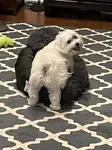How to Clean Puppy Tear Stains
Learn how to prevent and remove tear stain problems for good
If you're the owner of a white dog, like the eye-catching Coton de Tulear (though they’re not all white, of course), you're probably aware of the challenge of tear stains which can really diminish their stunning appearance.
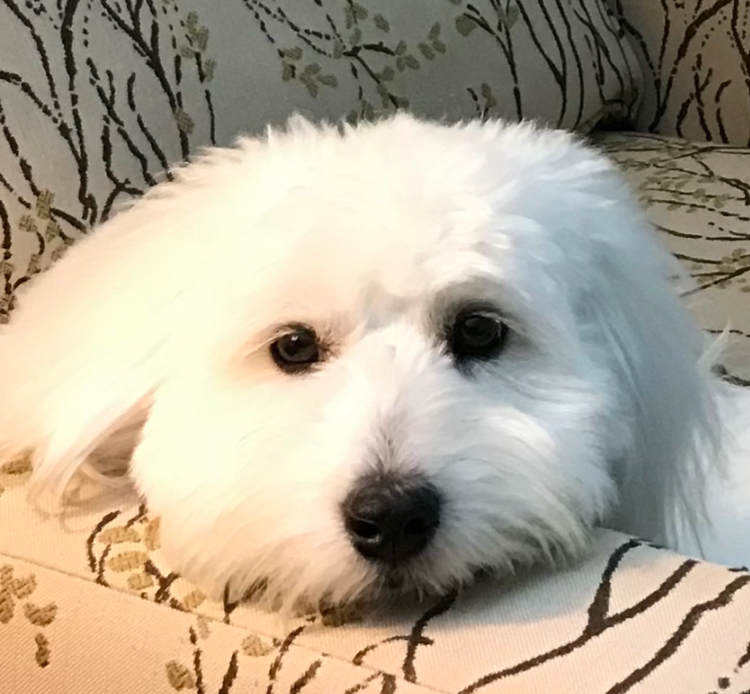
Puppies sometimes have tear staining when teething but often grow out of it. But many dogs continue to have staining issues throughout their adult years as well.
We all love it when our Cotons look cute, but tear-free eyes and stain-free coats aren’t about just looks; they also signify your dog’s health and well-being.
Getting a handle on tear staining requires a two-pronged approach: dealing with existing stains and treating the underlying cause to prevent further staining. Factors like diet, hygiene, and your dog's environment play crucial roles.
Most of this article will focus on tear stains since that’s the most common concern I hear from Coton parents. However, other areas where staining occurs include the paws, face, neck, and anywhere they lick themselves.
Understanding Tear Stains in White Dogs
First, a little science. According to The Forever Dog by Dr. Karen Becker, “If a pet’s tear stains are dark red, they’re the result of porphyrins, which are iron-containing waste products from the breakdown of red blood cells that can be excreted in tears and saliva. If the stains are brown in color, it indicates a yeast infection on the face”.
All dogs have porphyrins, but you'll notice the stains more on white or light-colored dogs.
Medical causes for tear stains
Other causes for staining include
- Production of excessive tears
- Excessive licking caused by allergies
- Ingrown eyelashes
- Small tear duct openings
- Environmental irritants, such as chemicals, smoke, or pollen
- Infections
- Eye injuries
- Puppy teething
- Poor nutrition
Five Prevention Strategies for Tear Stains
Before diving into the tips below, it's crucial to rule out any medical reasons for your pet's tear stains. Once you've got the all-clear, these tricks will help keep their eyes sparkling and their coat in pristine condition!
No. 1 – Proper cleaning:
Regularly brushing and bathing your Coton with a gentle shampoo and warm water can help reduce tear staining. Use a damp cloth or non-toxic wipes once or twice a day, especially after being outside.
Keep the hair around your dog's eyes trimmed to minimize the risk of irritation. For long hair breeds like the Coton, regular trimming will prevent hair from poking into the eyes, which can cause excessive tearing. After trimming, a clean towel or a damp cloth should be used to wipe away stray hairs.
Choosing safe and effective cleaners for eye area
When managing tear stains in your white-coated dog, selecting the right products and tools is essential for effective cleanup and care of the eye area.
Tear Stain Removal Products
Various tear stain remover products are available to address excessive tear production and the resultant reddish-brown stains on your dog's light-colored coat. Look for cleaners specifically designed for use around the eyes that are gentle yet effective at breaking down stains.
Here are some options:
- Wipes and Pads: Pre-moistened wipes or soft pads soaked in a tear stain removal solution can gently clean the stained area around your dog's eyes. They are convenient for daily use.
- Soft Powders: These can help to absorb excessive tears and prevent the wetness that leads to staining. Powders should be applied carefully to avoid any contact with the eye's surface.
- Tear Stain Remover Liquids: Liquid solutions are applied directly to the dog’s tears and stained fur with a cotton ball or pad. They often contain ingredients to lighten the stains safely.
Not all products will work the same for every dog, and it's important to monitor how well a tear stain removal product is working for yours.
Consider:
- Ingredients: Look for items with natural components that are safe for your dog's eye area and won't irritate if an accidental contact occurs.
- Sensitivity Test: Before using a product extensively, test it on a small portion of the stained area to ensure your dog doesn't have an adverse reaction.
- Visible Results: Over time, you should observe a noticeable decrease in the intensity of the reddish-brown stains and reduced watery eyes.
Natural home remedies for tear stains
Embracing natural remedies can be a gentle and more affordable way to address tear and coat staining. Here are some suggestions recommended by our Coton community:
- Baking soda and water may help remove stains. Create a paste and apply to your dog’s coat. Allow to sit for 20 minutes (good luck with that!) and rinse thoroughly.
- Lemon juice diluted with water put in a spray bottle can be effective, but ensure you don’t get any in the eye.
- Contact lens solution that contains boric acid can lighten the stains by breaking down the iron in the porphyrins.
- Organic, virgin Coconut oil has antibacterial properties that can help keep the area clean and might lighten the stain.
- Apple Cider Vinegar can be used for an all-over coat treatment. Mix ACV with water (a good ratio is 1 part ACV to 3 parts water) and use it as a rinse after your dog's regular shampoo. It can help prevent the growth of fungus and bacteria, which can cause staining. Remember to avoid the eyes and any open wounds.
No. 2 - Balanced Nutrition:
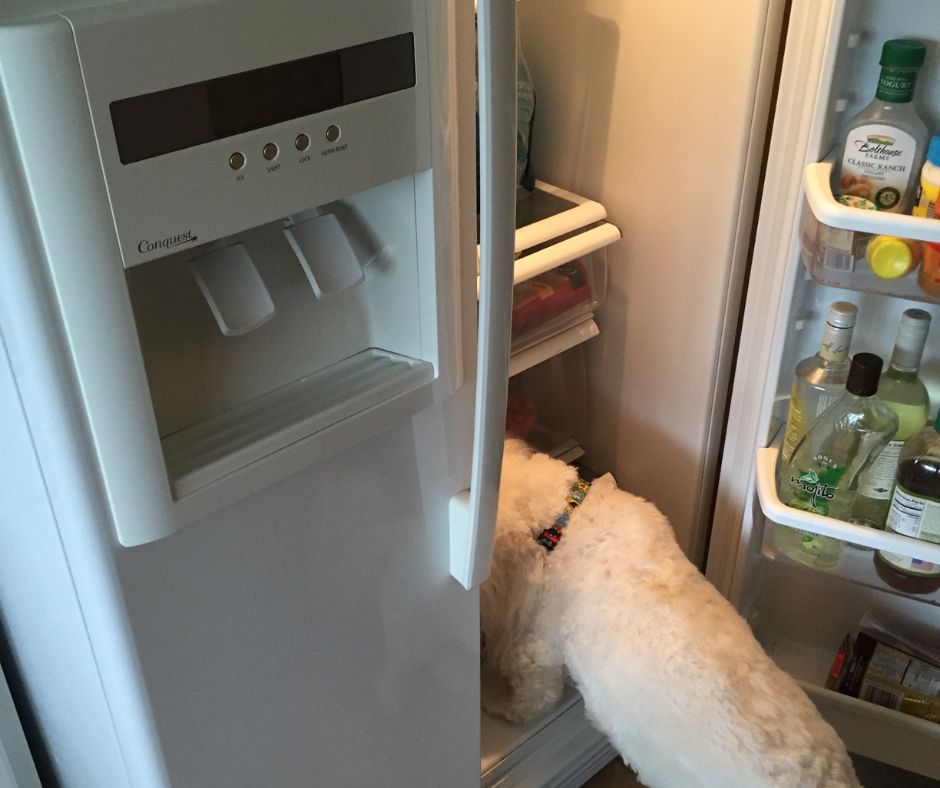
Ensure your dog’s food is high-quality and suitable for their specific dietary needs.
Many members of our Coton community have found that switching from processed dog foods to higher quality options, including treats, really makes a difference. I've seen this firsthand with my own dog.
My first Coton, Luc, was lucky to never experience any tear or coat staining. However, my new Coton, Lucy, started showing these signs after a recent change in her diet.
Lucy has to take Phenobarbital for seizures, which led to a weight gain of 8 pounds and subsequent back pain. To address this, our vet recommended a prescription low-calorie dog food, which unfortunately caused her once pristine white coat to develop a reddish-brown stain around her mouth and neck.
After switching back to her regular diet, the improvement was noticeable almost immediately—the stains around her mouth started to fade. This experience really highlights the impact that diet can have on our pets' appearance and well-being!
I always recommend starting with changes to food and water before trying supplements or cleaning products.
General guidelines include:
- Avoid highly processed foods high in additives and dyes
- Avoid foods your dog may be sensitive or allergic to. Also, avoid ingredients prone to cause staining such as beets, tomatoes, wheat, corn, soy, red meat, artificial colors, flavors, preservatives, and dairy products.
No. 3 - Water Quality:
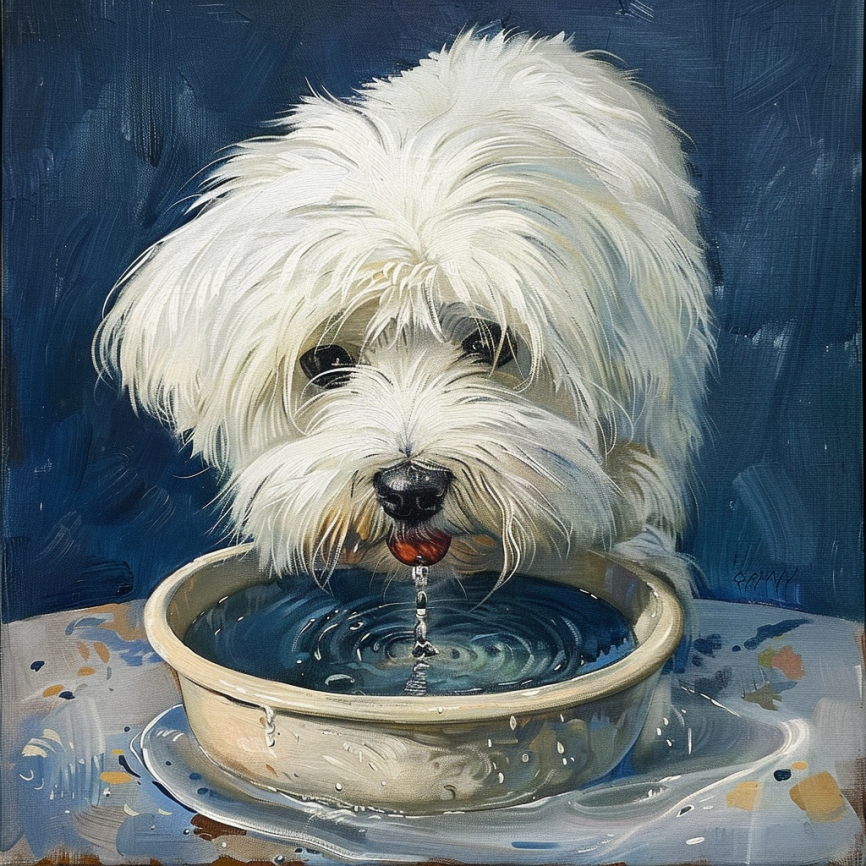
Provide your dog with filtered, spring, or distilled water to prevent stains caused by minerals found in hard water.
Tap water can be problematic because it contains minerals, such as iron, which can leave brownish-red stains on a dog’s coat.
I like providing spring water because it eliminates the bad minerals but includes some healthy minerals unavailable in distilled water. I was surprised to learn that distilled water is not the best water source for our dogs.
According to PetMd a small amount of distilled water is acceptable, but if it’s the only source of water for your dog, it can cause serious side effects because it lacks minerals and can cause the body to lose electrolytes, which can lead to low blood levels.
Ensure the water is fresh, changing it multiple times a day if possible.
No 4 - Choose the right dog food bowls:
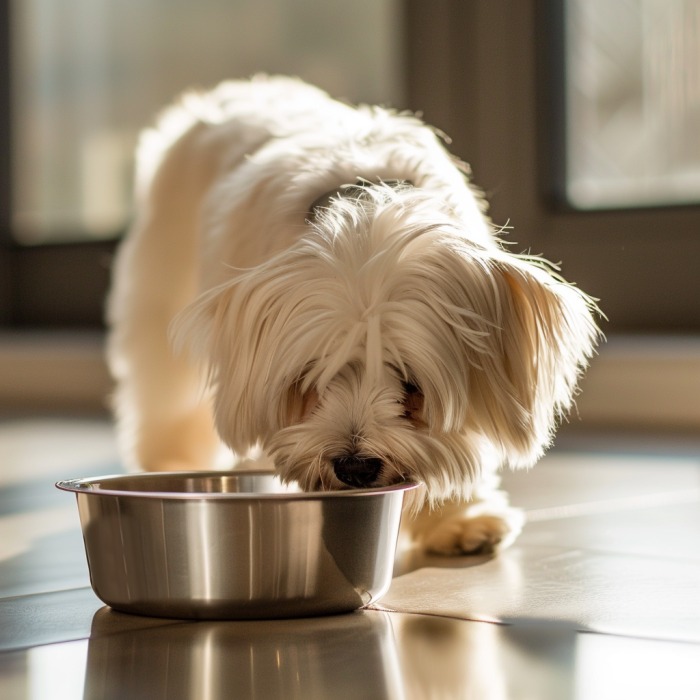
Even your choice of dog bowls can have an impact on your dog’s coat. Here are some guides to help you choose the best option:
- Plastic: Can leak harmful chemicals into your dog's food and water. According to Dr. Becker, this can cause “plastic dish nasal dermatitis” and can leave your dog’s nose and lips pink and irritated.
- Ceramic: Poor-quality ceramic dog bowls have been linked to lead poisoning, so opt for a lead-free, high-quality dog bowl. Harmful bacteria have been found in bowls with even the finest cracks, so check your ceramic dishes frequently and discard bowls with any cracks.
- Glass: Glass is non-porous and easy to clean, but as we all know, it can be fragile. So, if you have a dog like Lucy who loves to push her dish with her nose after she eats, it’s probably not a good choice. (She likes to make sure she gets every morsel of food from her dish).
- Stainless Steel: These are the most common and my favorite because they’re durable, lightweight, rust-resistant, and less likely to break than plastic or ceramic bowls. They're also easy to clean and don't collect bacteria or odors as plastic can. But some cheaper stainless steel bowls have been found to have heavy metal contamination, so once again, choose a high-quality bowl from a trusted supplier.
The bottom line is that no matter what type of bowl you choose, ensure it’s high quality, clean it often, and check for cracks.
No. 5 - Monitor for Allergies:
Keep an eye on your dog for signs of allergies, as these can increase tear production and lead to staining. Allergies can result from the foods they eat or environmental conditions such as pollen, grass, plants, and dust. The tears they produce from the allergic reaction can lead to staining.
You can learn more about allergies here.
Medical Treatments and Interventions
When at-home methods don’t yield results, it’s time for getting professional help to rule out health issues.
Signs that warrant a vet visit include:
- Odor or skin irritation might indicate a yeast infection.
- Redness around the eyes can signal an eye infection or issues with the nasolacrimal duct.
- Sores or inflammation are symptoms that may point to bacterial infections.
A vet can identify the underlying cause and advise on the next steps.
They may prescribe medications or supplements, such as antibiotics, antifungals, eye drops, or supplements containing fish oil, flaxseed, or probiotics to help reduce inflammation and tear production.
But remember, every drug and supplement has the potential for side effects. It’s always advisable to try natural solutions before reaching for drugs.
Check out what our visitors have to say:
Check out what our visitors have to say about tear and coat staining: Tear staining problems and solutions
Home | About Me | Contact Me | Privacy Policy |Disclosure
Copyright© 2008- All Rights Reserved








